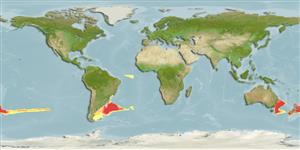>
Aulopiformes (Grinners) >
Scopelarchidae (Pearleyes)
Etymology: Scopelarchoides: Greek, skopelos = a lantern fish + Greek, archos = anus + Greek, oides = similar (Ref. 45335).
Environment: milieu / climate zone / depth range / distribution range
Ökologie
seewasser bathypelagisch; tiefenbereich 0 - 2000 m (Ref. 58018). Deep-water
Southwest Atlantic, Argentine basin and Southwest Pacific, off southern Tasmania.
Size / Gewicht / Alter
Maturity: Lm ? range ? - ? cm
Max length : 19.0 cm SL Männchen/unbestimmt; (Ref. 75653)
Kurzbeschreibung
Morphologie | Morphometrie
Rückenflossenweichstrahlen (insgesamt): 8-9; Wirbelzahl: 55. This species is distinguished from all other species of the family by the following characters: pectoral fin distinctly shorter than the pelvic fin; pelvic-fin origin anterior to a vertical through the first dorsal-fin origin; lingual teeth found over the basihyal and the first basibranchial; lateral-line scales 58 or 59; pigment stripes along the lateral line (Ref. 75653).
Life cycle and mating behavior
Geschlechtsreife | Fortpflanzung | Ablaichen | Eier | Fecundity | Larven
Motomura, H., P.R. Last and G.K. Yearsley, 2007. Scopelarchoides kreffti (Actinopterygii: Aulopiformes: Scopelarchidae) from off Tasmania, Australia: first records from outside the South Atlantic Ocean. Species Diversity 12:9-15. (Ref. 75653)
IUCN Rote Liste Status (Ref. 130435)
Bedrohung für Menschen
Harmless
Nutzung durch Menschen
Mehr Information
NamenSynonymeMetabolismusRäuberÖkotoxikologieFortpflanzungGeschlechtsreifeAblaichenSpawning aggregationFecundityEierEientwicklung
Alter/GrößeWachstumLänge-GewichtLänge-LängeLängenhäufigkeitenMorphometrieMorphologieLarvenLarven Pop.Dyn.RekrutierungDichteBRUVS
ReferenzenAquakulturAquakultur ProfilZuchtlinienGenetikElectrophoresesVererbbarkeitKrankheitenVerarbeitungNutrientsMass conversion
PartnerBilderStamps, Coins Misc.LauteCiguateraGeschwindigkeitSchwimmstilKiemenoberflächeOtolithsGehirngrößeSehfähigkeit
Tools
Zusatzinformationen
Download XML
Internet Quellen
Estimates based on models
Preferred temperature (Ref.
123201): 6.8 - 12.5, mean 8.4 °C (based on 119 cells).
Phylogenetic diversity index (Ref.
82804): PD
50 = 0.5313 [Uniqueness, from 0.5 = low to 2.0 = high].
Bayesian length-weight: a=0.01000 (0.00244 - 0.04107), b=3.04 (2.81 - 3.27), in cm total length, based on all LWR estimates for this body shape (Ref.
93245).
Trophic level (Ref.
69278): 4.4 ±0.8 se; based on size and trophs of closest relatives
Fishing Vulnerability (Ref.
59153): Low vulnerability (13 of 100).
